
Doughoregan Manor is a plantation house and estate located on Manor Lane west of Ellicott City, Maryland, United States. Established in the early 18th century as the seat of Maryland's prominent Carroll family, it was home to Charles Carroll, a signer of the United States Declaration of Independence, during the late 18th century. A portion of the estate, including the main house, was designated a National Historic Landmark on November 11, 1971. It remains in the Carroll family and is not open to the public.

The Charles Pinckney National Historic Site is a unit of the United States National Park Service, preserving a portion of Charles Pinckney's Snee Farm plantation and country retreat. The site is located at 1254 Long Point Road, Mount Pleasant, South Carolina. Pinckney (1757-1824) was a member of a prominent political family in South Carolina.

Blandwood Mansion is a historic house museum at 447 West Washington Street in Greensboro, North Carolina. Originally built as a four-room Federal style farmhouse in 1795, it was home to two-term North Carolina governor John Motley Morehead (1841-1844) under whose ownership it was transformed into its present appearance. It is believed to be the oldest extant example of the Italian Villa Style of architecture in the United States, and was designated a National Historic Landmark in 1988. In creating the design for Blandwood, architect Alexander Jackson Davis produced a popular prototype for American house designs in the Italianate style: a central tower projecting from the main facade. Saved from demolition in 1964 by preservation-minded Greensboro citizens, the house was opened as a museum in 1976 and remains open to the public today.

Highland, formerly Ash Lawn–Highland, located near Charlottesville, Virginia, United States, and adjacent to Thomas Jefferson's Monticello, was the estate of James Monroe, fifth President of the United States. Purchased in 1793, Monroe and his family permanently settled on the property in 1799 and lived at Highland for twenty-four years. Personal debt forced Monroe to sell the plantation in 1825. Before and after selling Highland, Monroe spent much of his time living at the plantation house at his large Oak Hill estate near Leesburg, Virginia.

The Dodd-Hinsdale House was built in 1879 for the family of the Raleigh, Wake County, North Carolina, city mayor. It was constructed in the Italianate style, with some Second Empire embellishments.
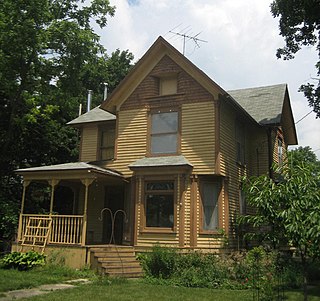
The Stephen Wright House is a home located in the Lee County, Illinois, United States, village of Paw Paw. The Queen Anne style home was constructed sometime between 1895 and 1906 by Paw Paw real estate speculator Stephen Wright. Located along a former Native American trail and stagecoach line, the home is in an area of very similar Queen Anne style homes which may have also been built by Wright. Wright had left the property by 1906 and sold the property to another Paw Paw resident who stayed in the house until his death. The Stephen Wright House was listed on the U.S. National Register of Historic Places on May 22, 2005.

Hampton Plantation, also known as Hampton Plantation House and Hampton Plantation State Historic Site, is a historic plantation, now a state historic site, north of McClellanville, South Carolina. The plantation was established in 1735, and its main house exhibits one of the earliest known examples in the United States of a temple front in domestic architecture. It is also one of the state's finest examples of a wood frame Georgian plantation house. It was declared a National Historic Landmark in 1970.
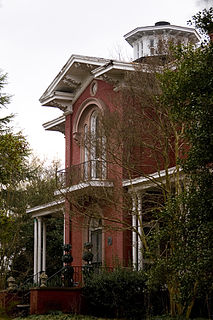
Montfort Hall is a home and registered historic landmark located in the Boylan Heights neighborhood of Raleigh, North Carolina. It is one of the few mansions in Raleigh that survived during the American Civil War era. The house was built for William Montfort Boylan in 1858 and is an example of Italianate architecture. The centerpiece of the house's interior is a rotunda supported by four Corinthian columns and lit by a stained glass window located on the roof. Montfort Hall was listed on the National Register of Historic Places in 1978 as Montford Hall and is a Raleigh Historic Landmark.
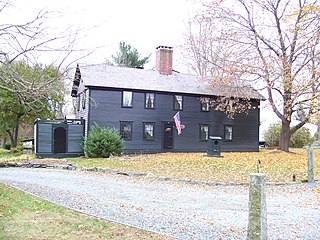
The Stephen Northup House is a historic house at 99 Featherbed Lane in North Kingstown, Rhode Island.

The William King Beck House, also known as River Bluff Plantation, is a historic plantation house on the Alabama River near Camden, Alabama. The main house was built in 1845 for William King Beck and is attributed to architect Alexander J. Bragg. William King Beck was an attorney from North Carolina who migrated to Wilcox County in the 1820s. He was the nephew of William Rufus King, the 13th Vice President of the United States.
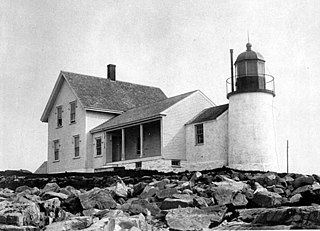
Winter Harbor Light is a lighthouse in Winter Harbor, Maine. It is located on Mark Island, a small island between the Schoodic Peninsula and Turtle Island, near the entry to the town's main harbor. The light was built in 1856 and was deactivated in 1933; it is no longer an aid to navigation, and is privately owned. The light was listed on the National Register of Historic Places as Winter Harbor Light Station on February 1, 1988.

Botany Bay Plantation Heritage Preserve/Wildlife Management Area is a state preserve on Edisto Island, South Carolina.

The Berryhill-Morris House is a historic farmhouse near the city of Bellbrook in Greene County, Ohio, United States. Built in the 1830s for an elderly veteran, it has changed little since its early years, and it has been named a historic site.

China Grove is a historic plantation house located near Oriental, North Carolina. Built sometime in the late-18th century to early-19th century, the Federal style home was named for a row of chinaberry trees that once led to its entrance. China Grove is one of North Carolina's most dramatically sited plantation homes, overlooking the Neuse River at one of its widest points, near the mouth of Dawson's Creek. The house was added to the National Register of Historic Places (NRHP) in 1973.

Hezekiah Alexander House in Charlotte, North Carolina, built in 1774, is the oldest house in Mecklenburg County, North Carolina. It was named to the National Register of Historic Places in 1970.

The Conro Fiero House, also known as Woodlawn Acres and latterly as the Mon Desir restaurant, was a revival-style Tudor mansion built in 1910 by Conro Fiero. Originally listed on the National Register of Historic Places on December 9, 1981, it was delisted on June 1, 2011, following its destruction by fire.
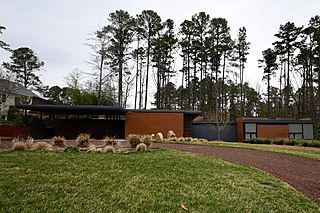
John C. and Binford Carr House is a historic home located in the Hope Valley Historic District of Durham, North Carolina. It was built in 1958, and is a one-story, "T"-shaped brick, steel, and glass Modern Movement style dwelling with a flat roof. It originally had 2,337 square feet and employs a Japanese aesthetic with a courtyard plan, a copper door with a simple copper appliqué design, and two sets of Shoji rice paper doors.

Perciphull Campbell House is a historic home located near Union Grove in Iredell County, North Carolina. The house was built about 1820 by Perciphull Campbell and is a two-story, frame I-house dwelling. It has a gable roof, stone foundation, and exterior chimneys with stuccoed brick stacks. Also on the property is the contributing smokehouse.
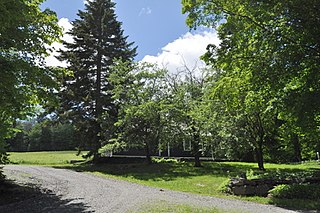
The Crows Nest is a historic farmstead property at 35 Sturgis Drive in Wilmington, Vermont. The 75-acre (30 ha) property includes rolling woods and a hay meadow, and a small cluster of farm outbuildings near the main house, a c. 1803 Cape style building. The property typifies early Vermont farmsteads, and is now protected by a preservation easement. It was listed on the National Register of Historic Places in 1998.

The Alexander Van Rensselaer House, also known historically as Restmere and Villalou, is a historic house at 1 Ichabod Lane in Middletown, Rhode Island. Built in 1857, it is a prominent example of Italianate architecture, designed by Richard Upjohn, with some of the earliest examples of Stick style decoration in the United States. It was added to the National Register of Historic Places in 2018.

























